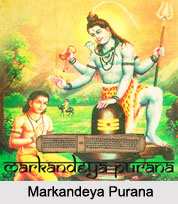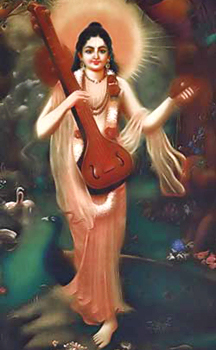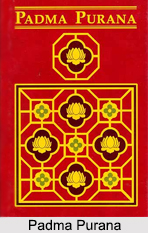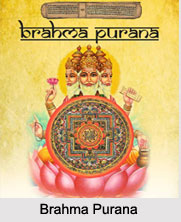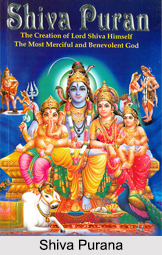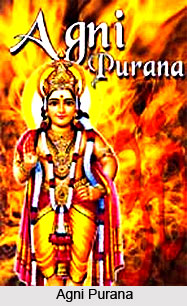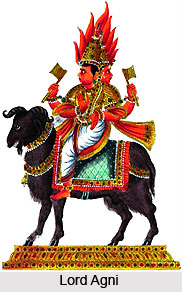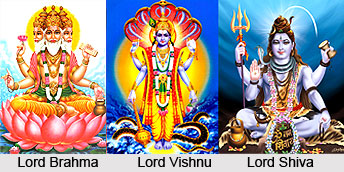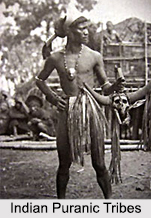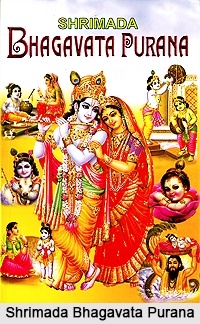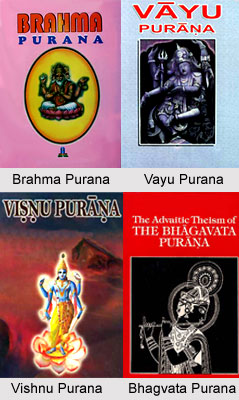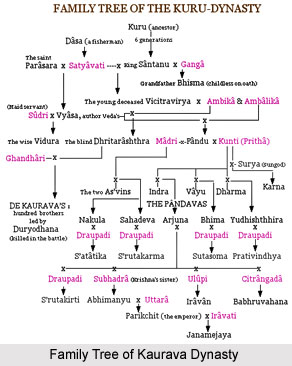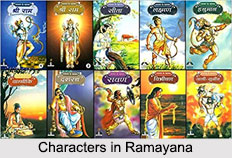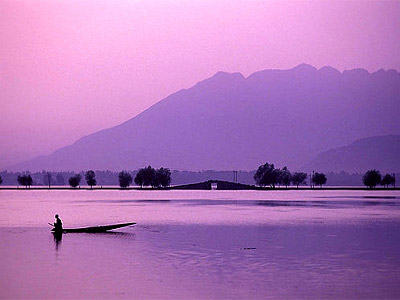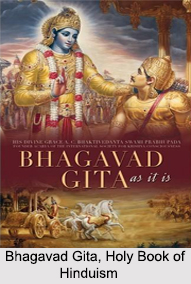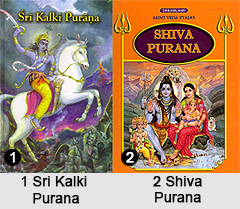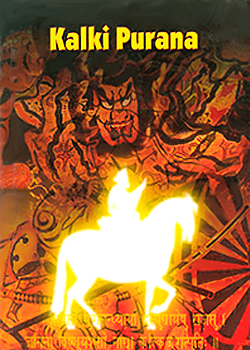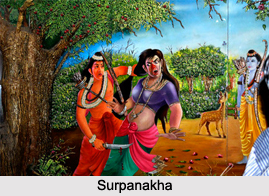Introduction
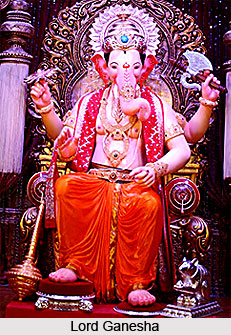 Adhyaya seventy one in Agni Purana has given a detailed description of the worship of Lord Ganesha. Lord Agni has said that nyasa which means the act of mentally locating a mantra needs to be performed in three stages. The first step involves Ganaya Svaha which is performed in the heart. Akdanstraya Svaha needs to be performed in the head; Gajakarnina Svaha is performed in the tuft of hair on the head. Gajavaktraya svaha acts as armour, Mohadaraya svaha is performed in the eyes and the Sadantahastya svaha acts as the weapon.
Adhyaya seventy one in Agni Purana has given a detailed description of the worship of Lord Ganesha. Lord Agni has said that nyasa which means the act of mentally locating a mantra needs to be performed in three stages. The first step involves Ganaya Svaha which is performed in the heart. Akdanstraya Svaha needs to be performed in the head; Gajakarnina Svaha is performed in the tuft of hair on the head. Gajavaktraya svaha acts as armour, Mohadaraya svaha is performed in the eyes and the Sadantahastya svaha acts as the weapon.
The God of Fire has said in his account of Lord Ganesha`s worship that the god gana, the preceptor, Paduka, Shakti and Ananta are to be located below the principal joint of the body and the Sadan is placed in the part above that. The Lord has said that the several Pitha Saktis such as Jvalini, Nanda, Surasha, Kamrupa, Uadaya, Kamvartiny, Satya, Vignansha are supposed to be located in the petals of the lotus shaped mystic diagram together with all the Mantras about Lord Yama, Lord Rama, Lam and Bam.
Lord Agni in Agni Purana discussing about the mode of worship of Ganesha has also mentioned the Gayatri Mantra which accompanies the worship of the lord. It says that individuals should know the god, the Lambodar (the big bellied god), should meditate upon the god Mohadara (the great bellied one) and let the minds of people be goaded to think of the god with the elephants head. Rather it can be said that at this juncture Agni has tried to say that one should concentrate on the Lord and should worship him with full dedication.
He has said that gods Ganapati, Ganadhipa, Ganesha, Gananayaka, Ganakrida, Bakratundu, Akadanstra, Mahodara, Gajavaktra, Lambakuksi, Vikala Vignanasha, Dhumrabara, Mahendra and others are to be worshipped in the petals of the painted lotus shaped diagram.
Methods of Worship of Ganesha
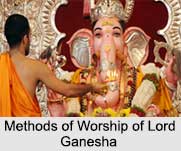 Methods of Worship of Lord Ganesha involve visible and invisible forms of adoration. However the visible form of worship is most popular in India. It is widely believed that Lord Ganesha is adored first before the worship of any other Gods. The Puranic legends mention that Lord Ganesha is invoked first before any other deity. Moreover the Lord should be worshipped before the beginning of any new projects.
Methods of Worship of Lord Ganesha involve visible and invisible forms of adoration. However the visible form of worship is most popular in India. It is widely believed that Lord Ganesha is adored first before the worship of any other Gods. The Puranic legends mention that Lord Ganesha is invoked first before any other deity. Moreover the Lord should be worshipped before the beginning of any new projects.
Pancha Upacharas of Lord Ganesha
The worship includes five kinds of offerings known as "Pancha Upacharas". The Pancha Upacharas signifies the Pancha Bhutas and the five types of offerings have different indications. These are:
i. Fragrance (Gandha) of white or red Sandalwood paste,
ii. Lighting of incense sticks (Dhupa),
iii. Lighting of oil lamps (Deepa),
iv. Offerings of fruits and sweets (Naivedyam) and
v. Offering of flowers (Pushparchana).
The offering of fragrance denotes the earth, the lamps or Deepa represents fire, the incense sticks signifies the air, the fruit and sweets denotes water and the flowers denote the sky. Among the fruits offered to the deity, coconut is regarded as one of the most important fruits. It indicates the head of the worshipper which is respectfully submitted to the Lord. The breaking of the coconut symbolizes the breaking of ego and unwanted qualities of the devotee.
Mantras for Worship of Lord Ganesha
Generally the Swastika is illustrated over a hard surface or a cloth. A coin is placed at the adjoining point of the cross. A full or partial (unbroken) betel-nut is placed over the coin. The "Swasti Vachana" is also chanted during the ritual. The sacred mantra can be recited as:
"Om Asya Karmanah Punyaham Bhavanto Bruvantu
Om Punyaham Om Punyaham Om Punyaham
Om Asya Karmanah Swasti Bhavanto Bruvantu Ayusmate Swasti
Om Swasti Om Swasti Om Swasti
Om Asya Karmano Rddhim Bhavanto Bruvantu
Om Rdhyatam Om Rdhyatam Om Rdhyatam
Om Swasti No Govindah
Swasti No Acyutanantau
Swasti No Vasudevo Visnur Dadhatu
Swasti No Narayana Naro Vai
Swasti Na Padmanabha Purusottama Dadhatu
Swasti No Visvakseno Visvaresvarah
Swasti No Hrsikeso Harir Dadhatu
Swasti No Vainateyo Harih
Swasti No Anjana Suto Hanur Bhagavato Dadhatu
Swasti Swasti Sumangalaih Keso Mahan
Sri Krsna Sac-Cid Ananda Ganah Sarvesvaresvaro Dadhatu"
While chanting the Swasti Vachana, the Brahmin priest distributes flower petals or rice or both and continues to recite the verses of the sacred mantra from the Vedic literature. After the Lord is invoked, the priest pours flower petals and whole rice over the betel-nut. This process is repeated by the worshippers as well.
Benefits of Worship of Lord Ganesha
Worshipping Lord Ganesha brings good fortune to one"s personal and professional life. This puja helps one become wise and knowledgeable. The souls of the worshipers are purified by the grace of Lord Ganesh. Financial difficulties are resolved easily by performing Ganesh puja and one can gain great success in their business.
Requirements for Worship of Ganesha
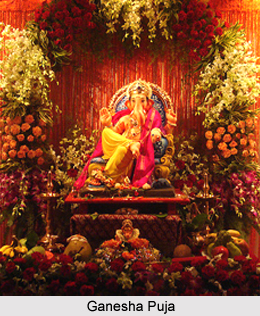 There are several basic requirements for the worship of Lord Ganesha. The Puranic texts mention various essentials which are required for the worship of Lord Ganesha includes various steps (Shodashopachara), namely Aavahanam, Aasanaam, Paadyam, Arghyaam, Aachamaneeyam, Snaanaam, Vastram, Yagyopaveetam, Gandham. Aksataam. Pushpam, Dhoopam, Deepam, Naivedyam, Tamboolam and Dakshanaam.
There are several basic requirements for the worship of Lord Ganesha. The Puranic texts mention various essentials which are required for the worship of Lord Ganesha includes various steps (Shodashopachara), namely Aavahanam, Aasanaam, Paadyam, Arghyaam, Aachamaneeyam, Snaanaam, Vastram, Yagyopaveetam, Gandham. Aksataam. Pushpam, Dhoopam, Deepam, Naivedyam, Tamboolam and Dakshanaam.
The worship or Ganesha Puja includes various objects which are mentioned below-
* Ganesha Idol - An image of the deity created of plaster of Paris, clay from bank of a river or metal.
* Kalash or Kamandalu - A sacred and traditional pot used for storing drinking water
* Tamhan or Purnapatra - A plate made of steel, copper or silver used in the rituals
* Panchpatra and Pali - A small steel, copper or silver pot with spoon for use in the worship rituals
* Gandha or Astagandha - Sandalwood paste mixed with water
* Akshata - Kumkum and Rice Flakes
* 21 kinds of Flowers and Leaves (Bel, Tulsi leaves)
* Shankha or Conch
* Fruits and Other Eatables (Bananas, Plum, Pomegranate, Guava and Black Plum)
* Ghantika or Bell
* Dhoopa or Incense Sticks
* Niranjan or Diya - A lamp with a ghee immersed wick
* Abir or Bukka (Black powder)
* Samai - Oil Lamp made of silver, Brass or Stainless Steel
* Kapas Vastra - Chain of small cotton balls with Kumkum and Haldi (Turmeric)
* Janvi Jod or Sacred thread
* Kumkum and Haldi (Turmeric) powder
* Gulal - Fragrant coloured powder
* Sindur or Vermillion
* Coconut
* Gulvaalu
* Camphor
* Panchamrita - A mixture of ghee, sugar, honey, curd and milk
* Naivedya - Offerings of various sweets and 21 modakas
* Paan or Beetle nut leaves
* Mango tree leaves
* Perfume or Attar
* Round Beetle nuts
* Jaggery and dry coconut
* Rangoli
* Saffron or Kesariya
* 21 Durva grass or Bermuda grass
* Unbroken rice
* New Garments
* Holy water from sacred river
* Sandal powder
* Dakshina - Offering in the form of coins
* Yajnopavitam (Yagyopaveetam) - Sacred Thread
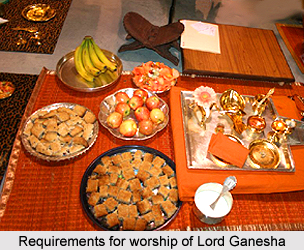 Around twenty-one varieties of flowers are used in Ganesha Puja. These flowers should be collected and plucked fresh from the trees and should not be collected after they have fallen from the trees. The flowers should not be stored for long. Moreover the buds which have not yet blossomed should not be offered to the Lord. The flowers that have been held in the left hand or have been washed with water or have already been offered in a previous puja is not allowed to be used in the rituals. The flower should be plucked with the right hand from the trees. The flowers should be plucked before the worshipper takes bath.
Around twenty-one varieties of flowers are used in Ganesha Puja. These flowers should be collected and plucked fresh from the trees and should not be collected after they have fallen from the trees. The flowers should not be stored for long. Moreover the buds which have not yet blossomed should not be offered to the Lord. The flowers that have been held in the left hand or have been washed with water or have already been offered in a previous puja is not allowed to be used in the rituals. The flower should be plucked with the right hand from the trees. The flowers should be plucked before the worshipper takes bath.
The worshipper should perform all formalities after taking his bath and should be seated facing the east direction. He should collect holy water from river Ganga and sixteen types of items for the worship rituals. The idol of Lord Ganesha should be installed on a specially made pedestal. In case an image of the Lord is not available, then a vase filled with rice should be installed on the pedestal. A betel nut should be put inside the vase and a mauli or sacred cord should also be coiled around the neck of the vase. Before the commencement of the rituals a lamp or Diya of ghee and Dhoopa or incense stick should be lit. These should be placed to the right of the pedestal. The worshipper should then summon his family deity by reciting sacred hymns and mantras. Then the performer of the ritual should be seated facing east and sip the water. He should then wash his hands chant mantras.
Later the worshipper is required to wear ring of Kusa grass or Pavitri and recite sacred mantras of Lord Ganesha. The worshipper then performs the Pranayama (inhaling of breath) for three times after the wearing of the pavitri. Then he is required to recite mantras or devotional hymns for self-purification and sprinkle water with his fingers or the Kusa grass. It is believed that the person, who chants the name of Lord Pundarikaksa, is purified internally and externally. Then the holy water should be sprinkled over all the items that were collected for offering to the Lord. After this, the Swasti Vachana (Swasti Vacana) mantra should also be recited as -
Om Asya Karmanah Punyaham Bhavanto Bruvantu
Om Punyaham Om Punyaham Om Punyaham
Om Asya Karmanah Swasti Bhavanto Bruvantu Ayusmate Swasti
Om Swasti Om Swasti Om Swasti
Om Asya Karmano Rddhim Bhavanto Bruvantu
Om Rdhyatam Om Rdhyatam Om Rdhyatam
Om Swasti No Govindah
Swasti No Acyutanantau
Swasti No Vasudevo Visnur Dadhatu
Swasti No Narayana Naro Vai
Swasti Na Padmanabha Purusottama Dadhatu
Swasti No Visvakseno Visvaresvarah
Swasti No Hrsikeso Harir Dadhatu
Swasti No Vainateyo Harih
Swasti No Anjana Suto Hanur Bhagavato Dadhatu
Swasti Swasti Sumangalaih Keso Mahan
Sri Krsna Sac Cid Ananda Ganah Sarvesvaresvaro Dadhatu
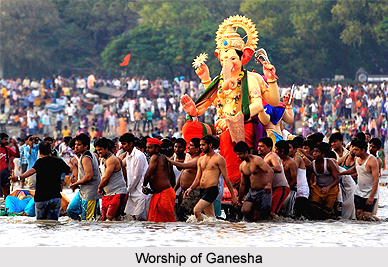 After reciting the Swasti Vachana mantra, the performer of the Ganesha Puja should then chant the sankalpa mantra for the auspicious beginning of the worship rituals. While reciting this mantra, he should pour the water, rice and other materials into a vase on the ground. Thereafter the worship of Lord Ganesha is started. The performer of the puja should invoke the Lord by conceiving the form of the elephant-headed deity and by chanting devotional hymns. The worshipper then invites the Lord to appear inside the idol and accept his offerings and adoration. After the invocation ritual, the idol is then sanctified by chanting of sacred hymns.
After reciting the Swasti Vachana mantra, the performer of the Ganesha Puja should then chant the sankalpa mantra for the auspicious beginning of the worship rituals. While reciting this mantra, he should pour the water, rice and other materials into a vase on the ground. Thereafter the worship of Lord Ganesha is started. The performer of the puja should invoke the Lord by conceiving the form of the elephant-headed deity and by chanting devotional hymns. The worshipper then invites the Lord to appear inside the idol and accept his offerings and adoration. After the invocation ritual, the idol is then sanctified by chanting of sacred hymns.
The following process is then followed for the worship of Lord Ganesha-
Presentation of the Seat (Aasanaam)
Lord Ganesha is offered a special seat or the lion throne after being invoked. The then prays to the Lord to accept the golden lion throne which is embellished with jewels and gems.
After the Lord is offered of the seat, the performer is required to wash the feet of the deity (Paadyam) while reciting a Ganesha mantra which cane be translated as "O god, O Lord of the obstructions, this is the water representing all the sacred places, mixed with fragrance and the other material. You kindly accept the same".
Offering of Arghya
Then the worshipper offers arghya or Arghyaam while reciting a devotional hymn.
Sipping of Sacred Water (Aachamaneeyam)
Then the devotee is required to sip the holy water of Ganga River. He is also required to chant the mantra.
Offering of Bathing (Snanaam)
The idol of Lord Ganesha is then bathed with sacred and fragrant water from the holy Indian rivers. The devotee also recites a mantra, "O god, the water of the Ganga is remover of all the sins, which is being offered to you for bathing. You kindly accept the same".
Five Types of Nectars
The deity is then bathed with a mixture of 5 kinds of nectars, namely sugar, honey, ghee, curd and milk. Washing the idol with these 5 kinds of ambrosias is regarded as auspicious. The bathing ritual is also performed with chanting of specific mantras.
The Puranic texts mention that apart from the five kinds of nectars, the Lord should be offered each of the individual nectar for the bathing, particularly Ghee, Curd, Sugar and Milk. The sugar is prepared from juice of sugarcane. It helps in removing the dirt. The following mantra is also chanted "O lord, I am offering the oil with fragrance of various flowers for smoothness which may be accepted by you". The idol can also be cleaned by clean sanctified water while reciting "O lord, I am offering the water of the Ganga, Yamuna, Godavari, Saraswati, Narmada and Sindhu rivers, which may be accepted by you".
Costumes (Vastram)
After the completion of the rituals related to Snanaam, Lord Ganesha is offered special garments. These costumes signify protection from heat, wind, cold, as well as shame.
Upper Garment
The Lord is also offered upper garment or Anga Vastra as a part of the worship of Lord Ganesha. It sis done while chanting one of the mantras of Lord Ganesha.
Ornaments
As Lord Ganesha has two consorts named Riddhi and Siddhi (or Buddhi and Siddhi), thus specific ornaments are offered to the deity for his spouses.
Yajnopavitam
The Yajnopavitam is offered to Ganesha while chanting devotional hymns
.
Apart from these, the following items are also offered during the worship rituals-
Perfume or Attar
The Lord is offered Attar (fragrance) which has been consecrated.
Unbroken Rice
The unbroken rice is an essential item in the adoration of Lord Ganesha. The rice is coloured and mixed with vermilion. The unbroken rice should be offered with devotion reciting while reciting mantras.
Flowers and Flower Garland
The flowers of Kalpavriksha or Mandara tree are also presented to the Lord while performing the rituals related to the Ganesha Puja. The Puranas also mention the garland of aromatic flowers should also be offered with utmost devotion in worship of Ganesha.
Sami Leaves
The worshipper is also required to offer leaves of Sami tree to the elephant-faced deity while chanting mantras.
Durva Grass
It is believed that twenty-one blades of Durva grass (Cynodon Dactylon) or Bermuda is required to be offered to Lord Ganesha at the time of worshipping Him. The following mantra is chanted while offering Durva grass-
Om Gan Ganpatye Namah
Om Ganadhipay Namah
Om Umaputray Namah
Om Vighnanashay Namah
Om Vinayakay Namah
Om Ishputray Namah
Om Sarvasiddhipraday Namah
Om Ekdantay Namah
Om Ibhavaktray Namah
Om Mushakavahnay Namah
Om Kumargurave Namah
Sindur
The offering of Sindur or vermilion is one of the basic requirements for the worship of Lord Ganesha. The deity is also is known as Sindura Vandana which means the one with the face like the vermilion.
Dhoopa or Incense
One of the important parts of the rituals is to burn dhoopa or incense sticks during the adoration of the Lord. It should be offered to the deity while reciting the Ganesha mantras.
Deepa and Diya (Lamps)
Diyas are required to be lighted during the puja of Lord Ganesha. The devoltional hymns of Lord Ganesha are also need to be chanted while offering lamps with wicks immersed in ghee.
Sweets and Modakas
Various types of specially prepared sweets, including laddoos and modakas and seasonal fruits are offered to Lord Ganesha during the ritual of Naivedyam.
Sandal Paste
The sandal paste is also required to be offered to Lord, reciting the devotional mantras.
Betels (Paan)
Lord Ganesha is also offered betels and betel nuts during adoration of the popular Hindu god.
Coconuts
The coconut is one of the most essential items while performing Ganesha puja. It is needed to be offered to the Lord in order to please him.
Dakshanaam
Dakshanaam or Daksina is offered at the concluding stage of the worship or puja. The Dakshina is offered mainly in the form of currency or coin. Sacred hymns on Ganesha are required to be recited while offering Dakshanaam. After this a bunch of flowers are also required to be offered to Lord reciting the mantras.
Circumambulation
The worshipper is then required to walk around the Ganesha idol while chanting the names and mantras of Lord Ganesha.
Dhyanam
The performer of the puja should stand before the idol of Lord Ganesha with folded hands and pray to the deity with devotion.

